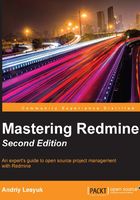
Chapter 3. Configuring Redmine
When talking about the web interface (that is, not system files), all of the global configuration of Redmine can be done on the Settings page of the Administration menu. This is actually the page that this chapter is based on (it has many tabs; the other administration pages will be reviewed in the appropriate chapters later). Some settings on this page, however, depend on special system files or third-party tools that need to be installed. And these are the other things that we will discuss.
You might expect to see detailed explanations of all the administration settings here, but instead, we will only review a few of them in detail, as I believe that the others do not need to be explained or can easily be tested. So generally, we will focus on hard-to-understand settings and those settings that need to be configured additionally in some special way or have some obscurities.
So, why should you read this chapter if you are not an administrator? Some features of Redmine are available only if they have been configured, so by reading this chapter, you will learn what extra features exist and get an idea of how to enable them.
In this chapter, we will cover the following topics:
- The first thing to fix
- The general settings
- Authentication
- Email integration
- Repository integration
- Troubleshooting